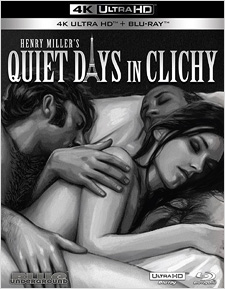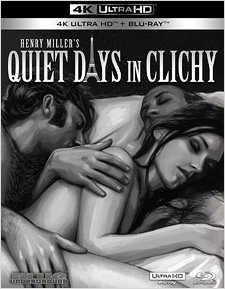Quiet Days in Clichy (1970) (4K UHD Review)

Director
Jens Jorgen ThorsenRelease Date(s)
1970 (October 25, 2022)Studio(s)
Dans-Svensk/SBA-Film/Grove Press (Blue Underground)- Film/Program Grade: B-
- Video Grade: A+
- Audio Grade: A-
- Extras Grade: B-
Review
The work of author Henry Miller was steeped in controversy when it was released during the early to mid twentieth century, particularly Tropic of Cancer, which eventually led to obscenity trials in the US due to its candid look at human sexuality. Much of it was self-autobiographical and covered the author’s time abroad as a struggling writer, having frequent trysts with the many women he met along the way. Among his works was Quiet Days in Clichy, eventually adapted into a film by Danish filmmaker Jens Jorgen Thorsen in 1970 and causing its own share of controversy.
The storyline concerns a pair of single men, Joey (Paul Valjean) and Carl (Wayne Rodda), who share an apartment in Paris during the 1960s, both impoverished writers and both eager to hop into bed with any of the women in the area. We mostly follow Joey (Henry Miller by proxy) as he engages with the opposite sex to great success. Outside of that description, there’s no real narrative through line as this is a snapshot of an era, or rather a slice of life. No moral lessons and no happy endings—or any ending for that matter—are to be had here. It’s a tale presented as a surrealistic stream of consciousness, jumping from one mischievous activity to the next.
Quiet Days in Clichy (aka Stille dage i Clichy) is also a somewhat fragmented, documentary-style piece. It uses everything from thought bubbles to narration to highlight the thoughts of Joey, as the “story” is almost exclusively told from his point of view. It’s also a completely blunt work: highly sexist, xenophobic, and debaucherous, but at the same, Joey and Carl treat the women that come and go in their lives as special. They never mistreat them, but at the same, they have very little morals when it comes to whom they sleep with, frequently referring to any and all of them using the dreaded See You Next Tuesday. At one point, Carl brings home a 14-year-old girl and raves about what a wonderful lover she is, despite not having much going on upstairs. As such, these two have very blasé attitudes toward underage sex, venereal disease, and just sex in general.
At the same time, the film is very tongue-in-cheek, even fourth-wall breaking at times. The music and lyrics of Country Joe McDonald (of Country Joe and the Fish) serve as not only a storytelling device, but also as ironic commentary:
“Come on people and listen to me.
I’ll tell you the story of Carl and Joey.
The girls they fucked and the women they laid.
This is the story of the love they made.
Now don’t get excited, be patient please.
Just put your hand on your lover’s knee.
And during the movie if you get a chance,
Put your hand inside her pants.”
In other words, you’re not meant to take this film too seriously. Neither of these men are to be admired, but it’s fascinating and amusing to see just how far they will go in order to bed beautiful European women. There’s an abundance of nudity on display, and in a couple of instances, brief hardcore shots, but it winds up as a cavalcade of perverted endeavors, occasionally reflecting on life and society. For one brief instant, Joey tells Carl about himself and the world as the camera lingers on a beautiful black-and-white shot of late 1960s Paris in its full scope, even seeing other lands in the distance. It’s gorgeous, and it makes you realize that there’s more to this film than just pointless depravity.
Quiet Days in Clichy is so repulsively crude that it remains very effective over fifty years later. It’s not a film to love so much as it is one to get caught in the grip of. It’s also difficult to imagine what an audience in 1970 must have made of something like this. Judging by the thirty second prologue in which an off-screen, upper class, female voice warns the audience about the content of the film, promising them that they may leave if they want their money back, it’s no surprise that it was either banned or severely edited around the world, rarely seen in its full, uncut form. Many will despise it or even shut it off before the 20-minute mark, but those who stick with it will get a sense of time and place, one that no longer exists, AND one that allowed two promiscuous young men who were wrestling to survive on a few francs a day to eke out an existence—even if that existence is abhorrent to some viewers.
Quiet Days in Clichy was shot by cinematographer Jesper Hom on 35 mm black-and-white film, finished photochemically, and presented in the aspect ratio of 1.66:1. Blue Underground presents the film on 4K Ultra HD for the first time in its uncut and uncensored version from a new 4K 16-bit restoration of the recently-discovered original fine-grain camera negative, which was finished as a 4K Digital Intermediate, and graded for High Dynamic Range (HDR10 and Dolby Vision options are available). Many have seen the film over the years in very rough conditions as this was a film that never truly had anything close to a pristine presentation. Though Blue Underground previously released the film on Blu-ray, they’ve surpassed it completely here. It’s a little rough around the edges (with a style that Terry Gilliam’s Fear and Loathing in Las Vegas owes a debt to), but this is the finest the film has ever looked on home video. Gradations are perfect with deep blacks loaded with detail in the shadows, as well as solid whites and various shades of gray. The HDR grade soaks up the finer nuances in all lighting conditions, particularly around the city during the day, as well as at night. Grain is very well managed and detail is high. Occasional softness creeps in during opticals and faint damage along the edge of the frame is evident, as well as a couple of faint lines through the center of the screen, but none of it takes away from the thoroughly organic quality of the presentation. It’s outstanding.
Audio is included in English mono DTS-HD Master Audio with optional subtitles in English SDH, French, and Spanish. It’s an incredibly clean presentation, free of hiss, thumps, crackle, and other damage typically associated with films of this vintage. Dialogue exchanges are discernible while Country Joe’s music is large and in charge in the mix (not to mention a brief scene featuring Duke Ellington alumni Ben Webster performing a gorgeous, bluesy saxophone solo).
Quiet Days in Clichy on 4K Ultra HD sits in a black amaray case alongside a Blu-ray of the film in 1080p, which utilizes the same transfer (and looks quite good, too). The insert is double-sided and features new artwork on one side and Blue Underground’s original Blu-ray artwork on the reverse. Everything is housed within a limited slipcover featuring a collage of scenes from the film, many NSFW. The following extras are included on each disc:
DISC ONE (UHD)
- Deleted Scene (UHD w/HDR – 6:11)
- Theatrical Trailer (UHD w/HDR – 4:19)
DISC TWO (BD)
- Songs of Clichy (Upscaled SD – 11:13)
- Dirty Books, Dirty Movies: Barney Rosset on Henry Miller (Upscaled SD – 17:19)
- Midnight Blue Interview with Barney Rosset (Upscaled SD – 25:04)
- Deleted Scene (HD – 6:11)
- Theatrical Trailer (HD – 4:19)
- Poster & Still Gallery (HD – 76 in all)
- Book Cover Gallery (HD – 24 in all)
- Court Documents Gallery (HD – 12 in all)
In Songs of Clichy, Country Joe McDonald treats us to a performance of the title song, but also discusses how he got involved with the film, its content, the era in which it was made, being exposed to feminism after the fact, and his reflections on the whole experience. In Dirty Books, Dirty Movies, Barney Rosset, who was a friend of Henry Miller and a publisher of his work, talks about the controversial author, the difficulties in releasing his books, the fact that Tropic of Cancer and Quiet Days in Clichy were both shooting at the same time in the same city, troubles with showing the film I Am Curious (Yellow), the court case involving the film and it disappearing afterwards, and his parting thoughts on Henry Miller. Midnight Blue was a public access TV show hosted by Screw magazine publisher Al Goldstein, and in 1989, he interviewed Barney Rosset about his career. In the Deleted Scene, we see Joey trying to go to sleep again, dreaming of various things, and once again waking up hungry (with what appears to be a cameo by Jens Jorgen Thorsen, who rolls on the ground over and over off a pier and into the water). The three still galleries contain a total of 112 images. The Poster & Still Gallery features 76 stills of posters, newspaper clippings, pressbooks, promotional and behind-the-scenes stills, lobby cards, and home video and soundtrack artwork. The Book Cover Gallery features 24 stills of different covers for Henry Miller’s book. The Court Documents Gallery features 12 stills of documents pertaining to the seizure of the film by customs in the United States, the subsequent court case, and a USPS document detailing the seizure of the novel Lady Chatterly’s Lover.
For many, Quiet Days in Clichy is a curiosity. It’s by no means politically correct, but it’s also not a pornographic film in the traditional sense. It’s merely a tell-all of sorts by a man who seemed to cater exclusively to controversy. Blue Underground’s 4K Ultra HD release sheds further light on Jens Jorgen Thorsen’s take on the material, giving us a presentation unlike any previously seen. It’s a tough film to recommend, but those with an appetite for adventurous cinema will appreciate it.
- Tim Salmons
(You can follow Tim on social media at these links: Twitter and Facebook. And be sure to subscribe to his YouTube channel here.)

